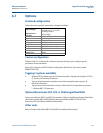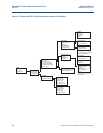
Reference Manual
00809-0100-4102, Rev AA
Appendix D: Network design best practices
May 2013
139
Appendix D: Network design best practices
Appendix D Network design best practices
Effective range . . . . . . . . . . . . . . . . . . . . . . . . . . . . . . . . . . . . . . . . . . . . . . . . . . . . . . . . . . page 139
All recommended practices should be followed to ensure highest data reliability. Deviation from
these best practices may require device repeaters in the network to maintain 99% data
reliability. The following are guidelines to achieve the best possible Smart Wireless Network.
1. Each wireless network field should be scoped to a single process unit.
2. Minimize the number of hops to the Gateway in order to reduce latency. A minimum of
five wireless instruments should be within effective range of the Smart Wireless
Gateway.
3. Each device in the network should have at minimum three devices with potential
communication paths. A mesh network gets its reliability from multiple
communication pathways. Ensuring each device has multiple neighbors within range
will result in the most reliable network.
4. Have 25 percent of wireless instruments in the network within range of Smart Wireless
Gateway. Other enhancing modifications include creating a higher percentage of
devices within effective range of the gateway to 35 percent or more. This clusters more
devices around the gateway and ensures fewer hops and more bandwidth available to
WirelessHART devices with fast scan rates.
5. Effective range is determined by type of process unit and the density of the
infrastructure that surrounds the network.
D.1 Effective range
Heavy Obstruction: 100 ft. (30 m). Typical heavy density plant environment. Cannot drive a
truck or equipment through.
Medium Obstruction: 250 ft. (76 m). Typical light process areas, lots of space between
equipment and infrastructure.
Light Obstruction: 500 ft. (152 m). Typical of tank farms. Despite tanks being big obstructions
themselves, lots of space between and above makes for good RF propagation.
Line of Sight: 750 ft. (230 m). No obstructions between WirelessHART devices and devices
mounted a minimum of 6 ft. (2 m) above ground or obstructions.


















